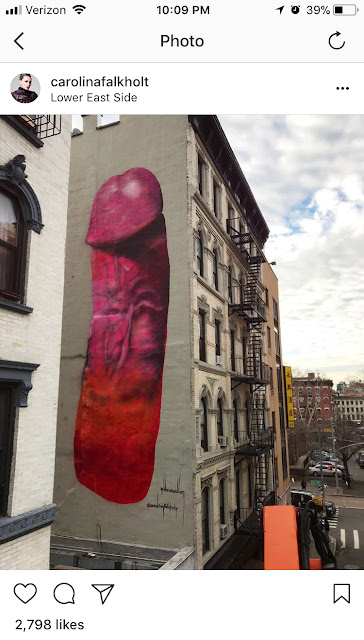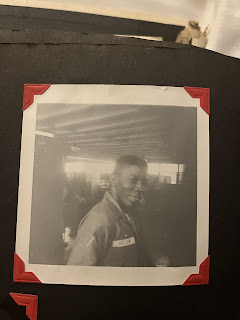Pinkie Sparks A Chat
While everyone was out celebrating and being holly and jolly this past Christmas holiday, artist Carolina Falkholt was up to more interesting things.
Located on Broome Street between Forsyth and Eldridge Streets if you're in town and care to take a look up close and personal, this lovely work of art popped up on the side of a Lower East Side building seemingly overnight and the surrounding residents, as well as the rest of the city, had a lot to say about it while others missed the point entirely.
Personally, I think it's great. Not only did Carolina use an excellent shade of pink, the mural actually stands for so much more. This phallic mural stands not only for objectification in a general sense but, and this is purely my reading of the art, a counter-argument to all the objectification women's bodies face on a daily basis. If this piece was of a woman's voluptuous breasts, yes, the outcry would be intense, but not nearly as much. Considering some of the loudest voices against this mural are men, I would wager there would be considerably less outrage and considerably more admiration, with comments explicit in their appreciation of the artist's work.
Welcome to the trials of being a woman, in which you can see your body ports splayed up on 10-foot billboards for everyone else to see too. A strong argument can be made that the objectification of women’s bodies leads to the sexual assault and rape of women (you see it on a billboard, you start to think all women make a sexy, smooch face if you diddle them a little, suddenly every woman who walks by is a sex pot, and when you finally decide to have "the experience," you think her “no” means “yes” even though it mostly definitely does not. Hence, a rape. End scene). Why are women's bodies so much more objectified and commodified than men's? If we're objectifying, it should be on an equal playing field, right? We all should be featured, otherwise none of us should be featured, correct?
Why does it hurt men's egos so much to see such a sexual symbol emblazoned on the side of a building this way? Is it because of the automatic comparison they make between the mural and their own member? Is it due to never having been objectified before and as a result feeling uncomfortable? Is it because they don't like being set out for public display and consumption? Maybe it's because they feel objectification should only be one-sided, for "the fairer sex" (not to mention only specific members of "the fairer sex" are allowed to be objectified but I digress)? I could go on and on surmising on the reasoning behind why the public, men in particular, felt so validated with this art. The point is, Carolina did an excellent job as an artist. She provoked the topic and sparked a conversation, one I would love to see expanded.
PS. I'd love to know your reactions to this! Leave them in the comments below.
**all puns included were most definitely intended
 |
| We'll call him Pinkie for short and see how long he lasts |
 |
| Caption and tags |
Located on Broome Street between Forsyth and Eldridge Streets if you're in town and care to take a look up close and personal, this lovely work of art popped up on the side of a Lower East Side building seemingly overnight and the surrounding residents, as well as the rest of the city, had a lot to say about it while others missed the point entirely.
 |
| A range of comments |
Personally, I think it's great. Not only did Carolina use an excellent shade of pink, the mural actually stands for so much more. This phallic mural stands not only for objectification in a general sense but, and this is purely my reading of the art, a counter-argument to all the objectification women's bodies face on a daily basis. If this piece was of a woman's voluptuous breasts, yes, the outcry would be intense, but not nearly as much. Considering some of the loudest voices against this mural are men, I would wager there would be considerably less outrage and considerably more admiration, with comments explicit in their appreciation of the artist's work.
Welcome to the trials of being a woman, in which you can see your body ports splayed up on 10-foot billboards for everyone else to see too. A strong argument can be made that the objectification of women’s bodies leads to the sexual assault and rape of women (you see it on a billboard, you start to think all women make a sexy, smooch face if you diddle them a little, suddenly every woman who walks by is a sex pot, and when you finally decide to have "the experience," you think her “no” means “yes” even though it mostly definitely does not. Hence, a rape. End scene). Why are women's bodies so much more objectified and commodified than men's? If we're objectifying, it should be on an equal playing field, right? We all should be featured, otherwise none of us should be featured, correct?
Why does it hurt men's egos so much to see such a sexual symbol emblazoned on the side of a building this way? Is it because of the automatic comparison they make between the mural and their own member? Is it due to never having been objectified before and as a result feeling uncomfortable? Is it because they don't like being set out for public display and consumption? Maybe it's because they feel objectification should only be one-sided, for "the fairer sex" (not to mention only specific members of "the fairer sex" are allowed to be objectified but I digress)? I could go on and on surmising on the reasoning behind why the public, men in particular, felt so validated with this art. The point is, Carolina did an excellent job as an artist. She provoked the topic and sparked a conversation, one I would love to see expanded.
PS. I'd love to know your reactions to this! Leave them in the comments below.
**all puns included were most definitely intended

Comments
Post a Comment